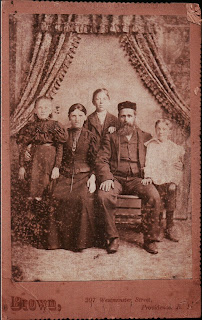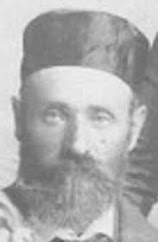I Know What I’m Doing!
At Jewish Newport
December 18, 2021
Edited by Beth Ginsburg Levine
Also at www.facebook.com/groups/jewishnewport
It was a pleasure to attend services at Newport’s Touro Synagogue on Saturday, December 18, 2021. We were able to have a minyan because of one family’s attendance. It was a little chilly with all the windows open. Most of us were prepared with coats, hats and gloves. Perhaps we sang a little faster!
Rabbi Marc Mandel has stopped his sermons to keep services as short as possible, but he usually slips in a few words about the parsha between aliyas. We read the last parsha in Genesis (Berishit), Parashat Vayechi, which was followed on December 25 by Shemot, the first parsha in the book of Exodus (Shemot).
Vayechi was the ending of the Joseph story. As Jacob was dying, he blessed his children as well as the two sons of Joseph. In truth, some of his blessings sounded like curses. It is customary to start with the oldest child, and this extended to Joseph's sons. Jacob’s sight was failing, and he started to bless the youngest grandchild first. Joseph assumed his father couldn’t see them, but Jacob insisted, “I know what I'm doing.”
The situation sounds familiar. It echoes the blessings that Jacob and his brother Esau received from their father Isaac. In that case Isaac really could not see, and was deceived by Jacob wearing an animal hide to make it feel that he had sun-baked skin like Esau. Result: Isaac got Esau’s blessing. Jacob knew what he was doing that time too.
Rabbi Mandel pointed out that this was the only case where there is not a separation (a new line or a nine letter break) between the books of Torah. “Rashi,” he said, “commented that it was because Jacob was confused and didn’t know what was going on.” That sounds like the human condition!
 |
| David Karnowsky and family? |
 |
| David Karnowsky |
David’s daughter, my grandmother, Sarah Karnowsky Pokross, who died in 1973, told me she was born in Kiev. During the Russian Empire, Kiev was both a city and a large province. David Karnowsky’s sister Rebecca Karnowsky Arbor, along with her husband Max Michael Arbor, (originally Obukkoski) also immigrated to the United States with two of their children. In 2000, her grandson Rueben Arbor, z.l., told me, “My father Joseph Myer Arbor was born in the same place as Tevye the milkman in Fiddler on the Roof.” Ten years later, I found Joseph’s WWII draft card, which gave Ignatovka as his birthplace. Ignatovka was also on their ship’s manifest from their arrival in Boston on October 10, 1913. In Yiddish it is Igantivka, which does sound like Anatevka from Fiddler on the Roof.
 |
| matzeva of Yehuda Stikleberg |
 |
| with the caretaker of the Ohel Hnativka, Ukraine |
But where was David Karnowsky’s ship's manifest? Naturalization papers documented his 1892 arrival in New York City. A David Karnowsky did immigrate to the United States in 1892, but he was from Poland. In May, I was exploring immigrants to Philadelphia from Makerev, which is just down the road from Ignatovka, and the name “Kahanovsky” popped out at me. Could we be searching with the wrong last name?
I searched Kahanovsky. The 1892 ship’s manifest for David and Sarah (my grandmother, daughter of his first wife) Kahanovsky popped right up, as did the manifest for Miriam (née Plotkin) and infant Joseph Kahanovsky, arriving in New York on March 25, 1893.
Wouldn't it be nice if David Karnowsky could personally tell us that his name was Kahanovsky? My sister Beth pointed out that he signed his naturalization papers in Yiddish. As I squinted, I saw that he used his original last name, Kahanovsky. If I had paid attention, I might have found out ten years ago!
 |
| 106 Sandwhich St Plymouth, MA |
I reviewed all this at the beginning of December after recovering from Covid. Congregation Beth Jacob in Plymouth, founded in 1909, lists its founders on its website. The list includes David Karnowsky, a junk dealer, and Miriam Plotkin Karnowsky.
The Rhode Island Jewish Historical Society has posted an article, “THE HELPING PROFESSIONS,” that mentions David and Miriam’s daughter, Esther, “Born in Plymouth, Massachusetts, in 1898, Esther Karnowsky Pritsker Taetle was a first-generation American-born daughter of David and Miriam (Plotkin) Karnowsky. Her father was a student of Talmudic studies, while her mother earned a living for the family by operating a small dry goods store.” Perhaps David was not successful as a junk dealer in Plymouth or selling furniture in Pawtucket, but you know what? I am proud to be descended from a Talmudic student!
As I perused the Congregation Beth Jacob website, I noticed that there was a new rabbi being installed on Friday, December 17. I attended Friday night services and the installation as the great grandson of a founder. The building is about the size of Touro Synagogue. It is now a reform synagogue. More people zoomed than came in person. Rabbi Estelle Gottman Mills was installed remotely by Rabbi Sally Preisand, the first female rabbi in the United States (who was ordained by a rabbinical school). Rabbi Presand spoke movingly about her life. She decided at age 16 to become a rabbi. She told us that a rabbi is a Jewish educator, and that is what she wanted to be. There were some bumps along the road, but she persevered.
Thank you for your perseverance with my meandering missives.
Shabbat Shalom!
